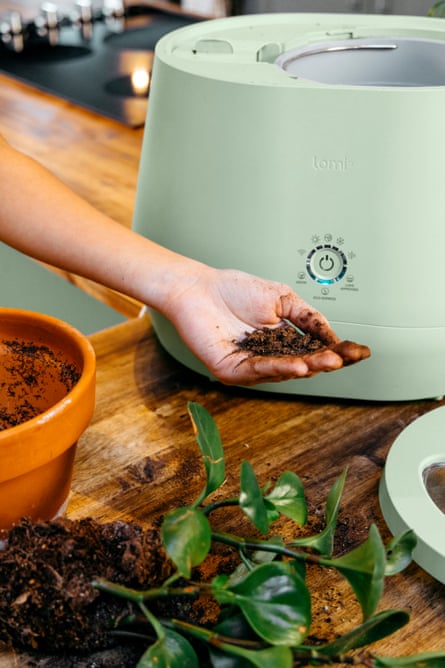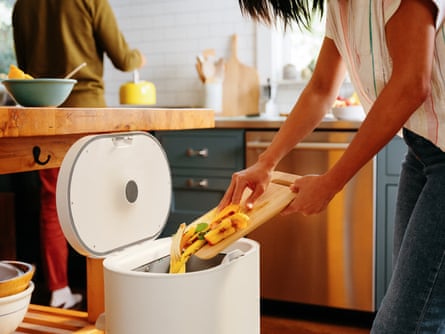
Michelle Cehn, founder of the popular Instagram account @vegan, built her reputation around her love for the planet – but food waste was something that she struggled with. “I’ve been wanting to compost, but I’ve always been really overwhelmed by an outdoor compost pile,” she said in a voiceover of a recent post that showed her picking fresh vegetables from the vine. “And so this year I started composting indoors with the Lomi electric composter.” In the short video, Cehn went on to explain how she simply dropped food scraps into the small electric bin on her countertop, pressed the button, and was left with “nutrient-rich plant food” a few hours later that she could use in her garden.
Lomi, the device Cehn was hyping, is just one of a new cohort of gadgets claiming they can eliminate kitchen food waste that are starting to gain traction, alongside brands like Mill, FoodCycler and Airthereal. Often marketed as electric “composters”, these appliances, which look a little like trash cans, dry and grind food waste into a mixture that some manufacturers claim can be used as a fertilizer and soil amendment, much like compost.
The rise of these appliances coincides with the rise of a serious food waste problem. In the US, only 5% of the 66.2m tons of food waste we generate every year gets composted. The result is that food is the single most common material sent to landfill in the US, where it releases methane, a potent climate-warming gas, as it breaks down. And for Americans who do want to compost, options are limited: while food waste collection has increased over the last decade, only 12% of households have access to a municipally supported food waste program as of 2023.
“Seventy per cent of Americans want to recycle organics and compost, but it’s a pain,” said Jeremy Lang, founder of Lomi. His company claims to solve that problem with a $400 gadget described as an “odor-free, mess-free solution to food waste” that allegedly reduces your carbon footprint by 127%. Lang believes these appliances’ ascendancy is only a matter of time.
“Just like there was a time before electric dishwashers and a time after, we believe that there’s a time before smart waste appliances and there will be a time after,” he said.
But composting experts say not so fast.
First off, though companies like Lomi and FoodCycler market their products as “kitchen composters”, what comes out of them is not actually compost, noted the composting and environmental consultant Ron Alexander.
Composting is a biological process that involves microbes decomposing organic materials, whereas appliances like the Lomi or FoodCycler simply grind down and dehydrate food scraps using blender-like blades and electricity-generated heat. (Though appliances in the category sometimes include packets of microbes or enzymes that users can add to the mix, “it is not realistic to believe that added microbes are effective at accelerating biological degradation and stabilization” in such a short time frame, according to Alexander.)
In other words, what comes out of one of these appliances might look to the untrained eye like dirt, but it’s not biologically stable in the way true compost is (which means it can rot once water is re-introduced, unlike compost).
That has not stopped many of these companies from sprinkling the term liberally throughout their marketing materials. Launched by the cellphone case-making parent company Pela through Kickstarter in 2021, Lomi was marketed as a way to “turn waste to compost with a single button”. Pushback from critics led to slight adjustments in terminology on the website, but as recently as 11 November, the brand was posting influencer ads to Instagram on its official account, claiming that after 24 hours of processing in the Lomi “kitchen composter”, food scraps were transformed into “soil”. FoodCycler, another brand in the category, describes its appliance as a “countertop composter”.
Lang, the Lomi founder, admitted to the Guardian that what comes out of the machine is “not compost”. Jud Cummins, product expert at Vitamix, the parent company of FoodCycler, likewise said that what comes out of the FoodCycler is “not compost”.
“Trying to make a food waste recycler make sense to a consumer who’s not aware that anything like this exists, the closest you can come to it is by referring to it as a composter. Like a composter, we are turning organics basically back into dirt. The output itself is certainly not compost, but we’re trying to create the connection for the consumer,” Cummins said.
Both Lomi and FoodCycler claim that, compost or not, the output from their machines is good for soil. Representatives said that in controlled trials on a farm in British Columbia, incorporating Lomi byproduct increased crop yield; FoodCycler claims that its output is “scientifically proven to be beneficial for optimal vegetation growth”.
When Alexander undertook his own home tests, he came away with different results. When treated as a soil amendment, the material from two different electric “composters” (the brands of which he declined to identify) got moldy and even killed some of the plants they were supposed to be fertilizing. To see if the machines at least erased the odor of food scraps so they’d be less of a draw for pests, bears or raccoons, he tried presenting two bowls to his dog, one with true compost in it and one with the output of one of these machines. His dog ignored the compost but immediately tried to eat the dehydrated food waste.
“Inferring that the material coming out of these units is a finished and ready-to-use material is pretty problematic,” he said. “‘Compost’ is a really cool, sexy, green term, so it doesn’t it doesn’t surprise me that people want to attach themselves to it. But I’m afraid it is really confusing and misleading to consumers in this case.”
Mill, a startup from the founders of the home thermostat makers Nest, offers a more straightforward characterization of its appliance, labeling its byproduct “Food Grounds”. It also notes that the grounds could “overwhelm your plants, get moldy or attract hungry critters” if not composted before adding to soil, and adds that “most households make more Food Grounds than gardens can handle”.
Rather than telling customers that they can sprinkle the byproduct in their backyard or house plants, Mill offers a subscription pick-up service that allows customers to send grounds back to the company, where the material is used as an ingredient in chicken feed.

“The best thing you can do is not waste food in the first place, the next best thing you can do is feed it to a person, and then the next best thing after that is to feed it to an animal,” said Harry Tannenbaum, co-founder and president of Mill, referencing the EPA-recommended approach to reducing food waste. The pathway to chicken feed got the go-ahead from the FDA this year.
Like its competitors, Mill comes with a hefty price tag: Mill, Lomi and FoodCycler all retail for just under $400 (though in Mill’s case, that’s actually a yearly payment for a subscription to Mill’s services, rather than a one-off payment for the bin).
That’s not to say there’s no future for these appliances. Removing the water from food waste can reduce its volume by 80%, which could mean fewer trips for garbage-hauling trucks and a reduction in their associated greenhouse gas emissions. In cities with chronic pest issues and limited space for household composting, compact appliances that allow people to separate food waste while reducing (if not eliminating) pest-attracting odors could be a boon. And overall, anything that gets more people separating out their food waste in the first place is a good start.
But to make a real dent in reducing food waste, it will almost certainly take parallel municipal waste infrastructure buildout, not just for-profit companies with gadgets only a small segment of society can afford. (Mill and FoodCycler reps say they have worked with municipalities in Tacoma, Washington, and Ontario, Canada, respectively on pilot projects that use their devices, but more time is needed to evaluate the larger-scale viability of these programs.)
For now, Alexander said he hopes these appliance brands will become more honest about what their products can and can’t deliver. If dehydrating and grinding up food can be part of a larger waste solution, great – just don’t pretend it’s something it’s not.
“Using the term ‘compost’ flippantly puts billions of dollars of composting infrastructure, and all the work that’s been done to build it, at risk,” he said. “I think it is going to put a blemish on real compost products. I hope that the FTC or the government steps in and puts an end to this.”



